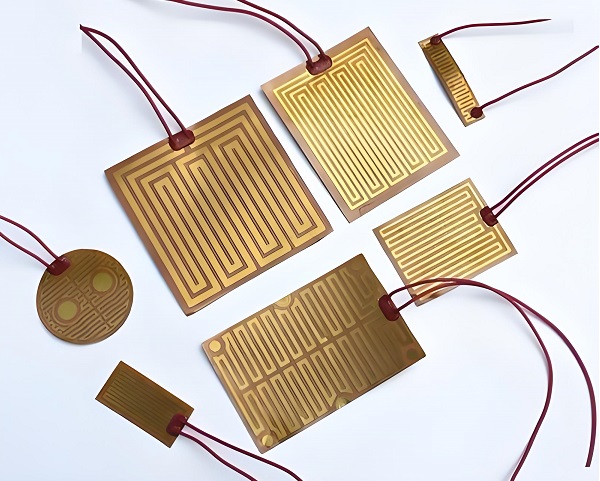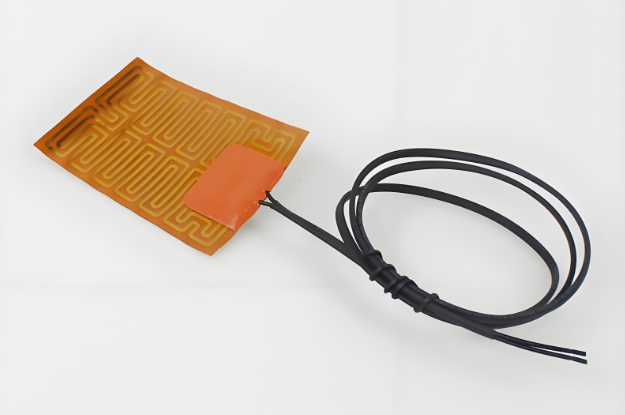In modern electronics, controlling temperature precisely is crucial. From battery warming systems in electric vehicles to 3D printer beds and aerospace sensors, Kapton heaters are a popular choice. Also called Kapton film heaters, these devices combine thin, flexible polyimide material with conductive traces to generate heat efficiently.
Their ultra-thin profile, high temperature tolerance, and uniform heating make them essential in compact or sensitive electronics where traditional heaters would be too bulky. In this article, we explore Kapton heaters, their design, performance characteristics, applications, and why partnering with a custom Kapton heater manufacturer like Danyu Electronics ensures optimal results.
A Kapton heater is a flexible thin-film heater made from Kapton polyimide film. Polyimide is a polymer known for its thermal stability, chemical resistance, and electrical insulation. A heating element, usually copper or a metal alloy, is etched or printed onto the film in a circuit pattern.
This construction allows the heater to:
Kapton heaters are available in multiple formats: strips, sheets, or fully customized shapes. The compact design ensures minimal thickness while maintaining high performance, ideal for devices where space is limited.

Kapton heaters are valued for their high thermal stability. Standard operating temperatures are:
The temperature depends on the power density, usually between 0.05–1.0 W/cm², and the surface to which the heater is mounted. Overheating can cause adhesives to degrade or delamination, so temperature control is critical.
For high-precision applications, thermistors or RTDs are often integrated to ensure accurate temperature feedback and prevent overshoot.
Manufacturing a Kapton heater is a precise process requiring careful material selection and advanced production techniques. Here is a detailed step-by-step breakdown:
1. Film Selection and Preparation:
Kapton heaters start with a polyimide film, usually 25–50 µm thick. The film is cleaned to remove dust, oils, or particles, ensuring strong adhesion for the conductive layer. For high-temperature applications, reinforced or double-layer Kapton films may be used to improve durability.
2. Conductor Layer Deposition:
A copper, nickel, or alloy foil is laminated onto the Kapton film using a high-temperature press. Copper foils are commonly 12–35 µm thick, selected based on the heater’s required power density. Adhesives are chosen to withstand high temperatures and maintain flexibility.
3. Patterning the Circuit:
The conductor layer is patterned using chemical etching or precision laser cutting. Chemical etching removes unwanted metal, while lasers create complex shapes and holes without mechanical stress. Trace widths can be as small as 0.08–0.1 mm for high-density heating designs.
4. Insulation and Protective Layers:
After patterning, a protective Kapton or adhesive layer is applied to the conductor. Some designs use high-temperature adhesives or silicone coatings to prevent delamination and ensure electrical insulation. This layer also adds mechanical durability.
5. Lead and Connector Attachment:
Flexible leads, often silicone-insulated or Teflon-coated, are soldered or welded to the heater. Connection points may include reinforcement or extra insulation to prevent mechanical stress and ensure safe operation during bending or movement.
6. Integration of Temperature Control Elements:
Thermistors, RTDs, or thermocouples can be embedded to provide accurate temperature feedback. Some heaters also include over-temperature cutoffs or fuses to prevent overheating and protect sensitive components.
7. Testing and Quality Control:
Each heater is tested for electrical resistance, insulation strength, and trace integrity. For large batches, automated optical inspection verifies that the conductor patterns match design specifications, ensuring consistent performance.
8. Customization and Finishing:
Finally, holes, cutouts, and connector placements are finalized to meet customer requirements. Laser cutting ensures precise shapes without damaging the heating element, producing a ready-to-install, thin-film heater suitable for various applications.
Kapton’s unique properties—thin, flexible, durable, and heat-resistant—make it useful in many areas:
Because Kapton heaters are lightweight, they are ideal where weight savings and compact designs are important.
Kapton is flame-resistant and often UL94 V-0 rated. It resists ignition and self-extinguishes if exposed to fire.
While the material itself is safe, designers must still:
Infrared (IR) heaters offer fast surface heating, but their adoption in electronics is limited because:
By contrast, Kapton heaters deliver direct, even heat, making them suitable for battery packs, medical devices, and precision electronics.

Running cost depends on power rating and electricity price. Example:
The low energy consumption makes Kapton heaters very cost-effective compared with larger resistive heaters. Efficient thermal control reduces energy waste, which is important in industrial or medical applications.
Kapton and silicone heaters are both flexible, but differences matter:
| Feature | Kapton Heater | Silicone Heater |
| Material Base | Polyimide film (thin, 25–50 µm) | Silicone rubber (1–2 mm thick) |
| Thickness | Ultra-thin, typically 0.1–0.3 mm | Thicker, 1.5–2 mm |
| Flexibility | Extremely flexible, can wrap around tight corners or surfaces | Flexible, but less conformable due to thickness |
| Maximum Continuous Temperature | 150–200°C | ~200°C |
| Short-Term Peak Temperature | Up to 260°C | Up to 220°C |
| Thermal Response | Heats up and cools down quickly due to low thermal mass | Slower response due to thicker material |
| Power Density | Up to 1–1.2 W/cm² (dry operation) | Up to 2 W/cm² (dry operation) |
| Durability | Very thin, can be fragile if mishandled | Thicker, more resistant to mechanical stress |
| Electrical Insulation | Excellent dielectric strength | Good, but thicker silicone can act as insulation |
| Mounting Options | Can be bonded using thin adhesive layers | Often mounted with thicker adhesive or embedded in silicone layers |
| Applications | Electronics, aerospace, battery packs, lab devices, 3D printing | Industrial machinery, medical equipment, larger devices needing higher wattage |
| Cost | Moderate, generally lower for thin designs | Slightly higher due to thicker material and molding processes |
| Customization | Laser-cut patterns, precise traces, very thin heaters | Molded shapes, thicker profiles, less precise trace resolution |
| Thermal Uniformity | Excellent for small, flat, or contoured surfaces | Good for larger areas but less uniform on tight curves |
| Weight | Extremely light | Heavier than Kapton |
Kapton heaters are preferred for compact, precise applications, while silicone heaters suit durable, high-wattage, or mechanically stressed environments.
Yes. Laser cutting is commonly used to:
Properly tuned lasers minimize thermal damage. This is especially important when the heater’s performance depends on precise trace widths and spacing.
Danyu Electronics specializes in custom Kapton heaters and thin-film heating solutions. Services include:
Danyu’s engineering team works closely with clients to optimize power density, thermal uniformity, and mounting options, ensuring every Kapton heater is reliable and long-lasting.
For custom projects, contact Danyu Electronics at sales@best-heaters.com to explore advanced Kapton heating elements and custom Kapton heaters.
1. What is a Kapton film heater?
A flexible thin-film heater using polyimide with etched copper or alloy traces for even, precise heating.
2. Can Kapton heaters withstand high temperatures?
Yes. Continuous operation up to 150–200°C and short-term peaks up to 260°C are possible with proper design.
3. Are Kapton heaters safe compared to infrared heaters?
Kapton heaters offer direct, uniform heat with integrated sensors for precise control, reducing risk of damage or burns.
4. Can Kapton heaters be fully customized?
Yes. Manufacturers like Danyu Electronics provide custom shapes, connector types, sizes, and power ratings.
5. How does Kapton compare with silicone heaters?
Kapton heaters are thinner, more precise, and suitable for compact electronics; silicone heaters handle higher mechanical stress and wattage.
Simply drop your email or phone number in the contact form, and we'll promptly reply you shortly.